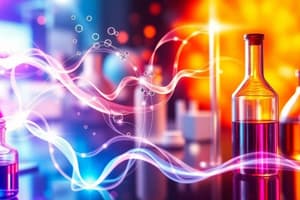Podcast
Questions and Answers
Quelle est la technique utilisée pour séparer et analyser les composés organiques volatils et semi-volatils tels que les hydrocarbures, les alcools et les pesticides?
Quelle est la technique utilisée pour séparer et analyser les composés organiques volatils et semi-volatils tels que les hydrocarbures, les alcools et les pesticides?
La chromatographie en phase gazeuse (CG)
Quelle est la phase mobile utilisée dans la chromatographie en phase liquide?
Quelle est la phase mobile utilisée dans la chromatographie en phase liquide?
Une phase liquide
Quel type de chromatographie est adapté pour séparer un large éventail de composés, des petites molécules aux grandes biomolécules?
Quel type de chromatographie est adapté pour séparer un large éventail de composés, des petites molécules aux grandes biomolécules?
La chromatographie en phase liquide
Quel est l'appareil utilisé pour détecter les composés séparés par chromatographie en phase gazeuse ou liquide?
Quel est l'appareil utilisé pour détecter les composés séparés par chromatographie en phase gazeuse ou liquide?
Quelles sont quelques-unes des industries où la chromatographie est largement utilisée?
Quelles sont quelques-unes des industries où la chromatographie est largement utilisée?
Qu'est-ce que la chromatographie?
Qu'est-ce que la chromatographie?
Quelles sont les applications de la chromatographie?
Quelles sont les applications de la chromatographie?
Quelle est la différence principale entre la chromatographie en phase gazeuse (GC) et la chromatographie en phase liquide?
Quelle est la différence principale entre la chromatographie en phase gazeuse (GC) et la chromatographie en phase liquide?
Quels sont les composants clés d'un chromatographe en phase gazeuse?
Quels sont les composants clés d'un chromatographe en phase gazeuse?
Comment commence le processus de chromatographie en phase gazeuse?
Comment commence le processus de chromatographie en phase gazeuse?
Flashcards are hidden until you start studying
Study Notes
Introduction
Chromatography is a widely used laboratory technique for separating mixtures into their individual components. It is based on the differential affinities of substances for a stationary phase and a mobile phase. This technique has various applications in different fields such as chemistry, biology, environmental science, and pharmaceuticals. In this article, we will delve into the fascinating world of chromatography, with a specific focus on gas chromatography and liquid chromatography.
Gas Chromatography
Gas chromatography (GC) is a powerful analytical technique used to separate and analyze compounds that can be vaporized without decomposition. This technique is widely used in the analysis of complex mixtures, as well as in the purification of individual compounds. The key components of a gas chromatograph include a sample injector, a column, a detector, and a data recording system.
The process begins with the injection of a small amount of the sample into the instrument, where it is vaporized and carried by an inert gas through the chromatographic column. The column is packed with a stationary phase that interacts with the sample compounds as they pass through. Different compounds interact with the stationary phase to varying degrees, causing them to separate and elute from the column at different times. The compounds are then detected by a sensitive detector, which generates a signal that is recorded and analyzed.
Gas chromatography finds applications in a wide range of industries, including environmental analysis, pharmaceuticals, food and beverage, and forensics. It is particularly useful for analyzing volatile and semi-volatile organic compounds, such as hydrocarbons, alcohols, and pesticides. The high sensitivity and accuracy of gas chromatography make it an indispensable tool for researchers and analysts.
Liquid Chromatography
Liquid chromatography (LC) is another essential technique for separating and analyzing complex mixtures. Unlike gas chromatography, liquid chromatography uses a liquid mobile phase to carry the sample through a stationary phase. This technique is highly versatile and can be adapted to separate a wide range of compounds, from small molecules to large biomolecules.
There are several types of liquid chromatography, including high-performance liquid chromatography (HPLC), size exclusion chromatography, and affinity chromatography. Each type has its unique applications and advantages, making liquid chromatography a widely used tool in research and industry.
In HPLC, the sample is injected into a stream of liquid solvent, which carries it through a column packed with a stationary phase. The different components of the sample interact with the stationary phase to varying degrees, leading to their separation. The eluent from the column is then passed through a detector, which generates a signal that is used to create a chromatogram. This chromatogram provides information about the composition and quantity of the compounds in the sample.
Liquid chromatography is used in a wide range of applications, including drug development, environmental monitoring, quality control in the food and beverage industry, and biochemical research. Its ability to separate and analyze diverse compounds with high sensitivity and precision makes it an indispensable tool for scientists and analysts.
Conclusion
In conclusion, chromatography is a fundamental technique with diverse applications in various scientific and industrial fields. Gas chromatography and liquid chromatography are two key branches of this technique, each offering unique advantages and applications. Whether it's analyzing environmental pollutants, purifying pharmaceutical compounds, or studying biomolecules, chromatography continues to play a crucial role in advancing scientific knowledge and improving quality of life. As technology continues to evolve, chromatography techniques are likely to become even more sophisticated and indispensable in the years to come.
Studying That Suits You
Use AI to generate personalized quizzes and flashcards to suit your learning preferences.




